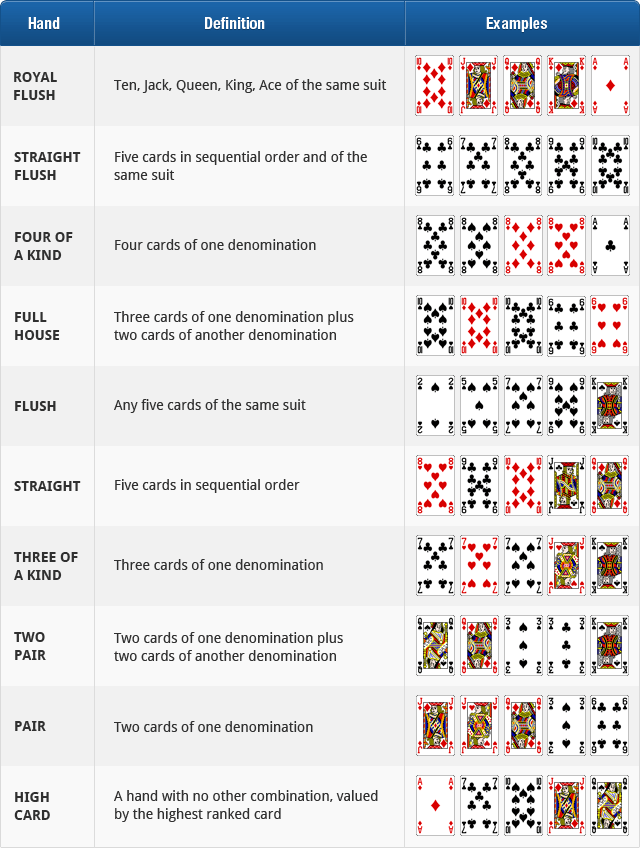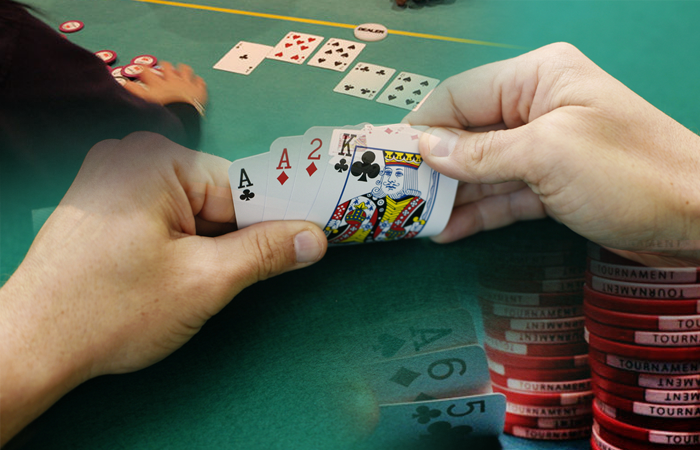Complete Guide to Omaha Poker
Omaha is a variant of poker that plays very fast. With four cards in your hand you will often find a reason to stay in a hand and keep the action going. With so many variations of Omaha Poker, it is a game that can take years to really get a good grasp on.
For a beginning player, Omaha can be one of the costliest games around. With so many possibilities coming at you in every hand, it is easy to make a few missteps. You’re going to have to really get used to being in certain situations in order to navigate them well.
That doesn’t mean that you have to donate money to the table every time you sit down, however. There are some good strategies for beginning Omaha players to take with them to the table when first starting out. In a game where a lot of players are sitting on draws, it is important to keep in mind that anything can, and will, happen.
If you are unfamiliar with the rule set of Omaha, be sure to check out our Rules of Omaha & Omaha Hi-Lo section before going further.
Rules of Omaha
To start things off we are going to take a look at the rule set for Omaha High (usually just simply called Omaha). With Omaha, can you play it as a high hand only game, much like with Hold ‘em. Or you can play it as split-pot game under the Omaha Hi-Lo variation, something we will touch on later.
With Omaha, you will notice that the game plays very much the same as Texas Hold ‘em but with a few of its own characteristics and differences. While we mentioned that the exact origin of the game in how it was created is not known, it no doubt derived from Texas Hold ‘em.
The hand rankings are exactly the same as with any variation of high hand only poker.
Just in case you are new to poker entirely, check out the graphic below to get an understanding of hand rankings before delving further.

Let’s now look at some of the specifics of Omaha…
The Deal
In Omaha, players receive four cards facedown, which is a significant difference from Hold ‘em, the game many players start with. The increased number of cards leads to more frequent pairs and suited connectors, but players can only use two of their four cards in a hand. Additionally, the two cards used may change from street to street, requiring more strategic thinking. Like Hold ‘em, Omaha follows a similar format with a rotating dealer button, forced blinds, and leftward action, but players may take longer to make decisions due to the increased card count.
The Flop
In Omaha, the flop is dealt after the pre-flop action, and players must use only two of their four cards. Action starts with the first live player to the left of the dealer and continues around the table. With a wide range of possible hands, including straight and flush draws, players must make strategic decisions on which cards to use. As the hand progresses, betting continues, and players try to make the best possible hand from their cards.
The Turn
After the turn card is dealt action once again continues with the first live player to the left and continues to the left from there. At this point your hand strength can change greatly, but so too can your opponent’s.
The likelihood of you now using at least one, if not two, different cards in your hand can be quite high. With still one more card to come, that can all of course change once again.
The River
The river card is dealt and action continues in the same fashion to the left. At this point, your hand is finalized. You are using two, and only two, of your hole cards to combine with the flop to make the best possible hand.
So how does it all work?
Showdown
At showdown, the players are asked to table their hands. Let’s look at some of the key things to consider as it pertains to Omaha at the completion of a hand:
- There is absolutely NO playing the board. In Texas Hold ‘em, if there is a spade flush on the board, for example, and your two hole cards are diamonds, you can simply play the board and have a flush. In Omaha, if there is a spade flush on the board and your hole cards do not contain any spades, it is not possible to play the board and have a flush. You MUST play the two cards that give you the best possible hand in combination with three, and only three, cards from the board.
- Additionally, if the board is Q-Q-Q-Q-5, no player has four of a kind with Queens. Again, because you MUST use two of your cards.
Basic Strategy
Let’s start with some basic strategy as it relates to high hand only Omaha. The first place to start is with your hole cards. In Texas Hold’em we all know the best possible hands we could be dealt. In Omaha, while there are some similarities, there are also a number of hands that become far less valuable in Omaha.
- Any four-card hand that has pocket Aces is always a must play.
- Any four-card hand that has pocket Kings is usually a must play. If other players at the table are being very aggressive pre-flop by putting in a third or fourth bet, most times one of them is holding Aces and you’ll want to throw your hand away. Likewise, when holding two Kings and your opponent or opponents are playing an Ace high flop aggressively, it’s a safe bet that one of them paired the Ace at least and you should fold.
- Pairs like Queens and Jacks, while good, are not nearly as strong a starting hand as in Hold ‘em.
- A hand like K-Q has some decent value pre-flop in Hold ‘em, but a hand like K-Q-X-X in Omaha holds little to no value. Unless of course one of the other cards is an Ace or you are holding a hand like K-Q-J-10, which gives you a lot of potential possibilities on a lot of flops.
- You can open up your starting hand range in late position because In Omaha, positions are paramount.
- Hands with no semblance of connectivity should never be played.
- Being dealt four of a kind is a terrible starting hand and should be thrown away. Being dealt three of a kind is also not optimal, but if it will cost you very little it may be ok to see a flop with A-A-A-X.
Position
Position in Omaha is a very big deal. Given that you have four cards in your hand, you can be looking at numerous possibilities once the flop is fanned out. Because there will almost always be players on a draw, players will usually bet their hands when they hit in an attempt to keep their opponents from seeing a free card. If you are last to act and it checks around to you, you should almost always fire a bet no matter what you’re holding.
You should always play position very strongly, especially when your opponents are being weak or passive. Stealing late before the flop when either one or no players has entered before you is almost always encouraged.

Wraps
One thing in Omaha that you will not find in other games is “wraps”. A wrap is a straight draw with 9 or more outs. It’s called a wrap because the player’s hole cards are said to wrap-around the board cards. In Hold ‘em, where players have 2-hole cards, the straightest outs possible is 8. But in Omaha, there are 4-hole cards and this results in straight draws that can have up to 20 outs.
For example, if the board is showing 9-8-2 and you are holding J-10-7-6, you can make a straight with any of the following cards:
- The four 5’s in the deck
- The remaining three 6’s in the deck
- The remaining three 7’s in the deck
- The remaining three 10’s in the deck
- The remaining three Jacks in the deck
- The four Queens in the deck
That is a total of twenty outs, giving you a massive, massive draw. You always want to play your wraps aggressively.
Redraws
Another common aspect of Omaha Poker is that of “redraws”. A redraw is simply when you have made a hand, but still have live draws to make an even better hand.
For example, let’s say the board is showing Q-J-10 and you are holding A-K-Q-Q. Currently, you have straight from the 10 to the Ace. You also have a redraw to a full house if the board pairs since you’re also holding trip Queens, and also a redraw to four of a kind should another Queen hit. Additionally, depending on the suits you could also have a redraw to a flush.
Common Mistakes
Just like with any game, there are some common mistakes that beginning players tend to make when first starting out.
- A Hold ‘em Mentality
- One thing new Omaha players do a lot is play their hands with Hold ‘em theory in mind. In Hold ‘em, flopping an 8 out straight draw is usually good. In Omaha, however, not so much. When holding four cards there are times you will flop 13-out, 17-out, and even 20-out straight draws. It is best to wait until one of these types of draws before getting heavily invested in a hand.
- Giving Free Card
- With so many draws out there on the flop usually, players would love to see a free card if given the chance. If you flop a strong hand, put the pressure on. There should be no free cards given in Omaha.
- Not Raising Pre-Flop
- New players can be fairly timid in Omaha and not want to bet too heavy before the flop since post-flop play can be intimidating for beginners. The last thing you want to do is the flop with a lot of players, however. So if you like you’re starting hand, always bring it in for a raise.
Fixed Limit vs Pot Limit
The two main types of high hand only Omaha games you will see are Limit and Pot Limit, with Pot Limit being a widely popular game. The two games play very differently. Pot Limit can be pretty loose and wild where any fixed limit game will have a slower, methodical pace to it.
In Limit Omaha, your bankroll or chip stack is rarely in danger of disappearing given that there is a limit to how much you can bet, and you will almost always know when a player has made their draw. In Pot Limit Omaha, however, your chip stack is almost always vulnerable.
There are a few key things to keep in mind when playing Pot Limit Omaha.
- Play Within Your Bankroll
- Given that this variation of the game can be extremely swingy, it is important to not get in over your head, no matter how good you think you are. Pots get pretty heavy in Pot Limit Omaha and some draws are hard to give up. If you miss though, kiss that bankroll goodbye.
- Don’t Overvalue Aces
- While Aces are always a great starting hand, don’t get too married to them early on. Flops will always see a lot of action and those Aces can shrink very quickly, even if the board doesn’t look too scary.
- Always Be Playing for the Nuts
- In Omaha, if you are going for a flush, always make sure it is the Ace high flush. The second nut flush, or second nut full house can cost you a ton of money.
- Stay in Control
- Pot Limit Omaha Poker can be one of the most tilting games in all of poker. One minute you’re in control of the hand, the next you are way behind and watching your chips be stacked by another player. Keep your emotions in check and remember that the game will always have its ebbs and flows.
$20-$40 Limit Omaha
- Pre-flop initial bet and raises in increasing increments of $20.
- Flop initial bet and raises in increasing increments of $20.
- Turn initial bet and raises in increasing increments of $40.
- River initial bet and raises in increasing increments of $40.
Fixed limit games are very straightforward in their betting approach. Easy to understand and simple to implement, when first learning a new game it is a great way to do so while being able to keep the amount being wagered somewhat manageable.
No Limit
No Limit Omaha is an uncommon game as Pot Limit is already action-heavy and often results in all-in situations. However, if you do come across it, understanding its rules is crucial. While the basic rules of Omaha apply, the no limit betting rules are straightforward – you can bet as much as your chip stack allows, with the minimum bet equal to the big blind and the maximum bet being your entire stack. This eliminates the need to calculate the pot or make a fixed bet amount.
Overview
By now you should have a good grasp on the specifics of how to play high hand only Omaha and the rules regarding the different betting limits that the game can be played with.
Here’s a quick recap:
- The game’s orientation follows that of Texas Hold ‘em, where there is a rotating small blind and big blind with action continuing to the left.
- Each player is dealt 4 hole cards.
- Of those 4 hole cards, a player MUST USE 2 of those cards no matter what the board texture is.
- You cannot play the board in Omaha. 5 spades on board does not equal a flush unless you have 2 spades in your hand.
- Omaha can be played either as a fixed limit or pot limit game. In very rare cases a game of No Limit Omaha might be spread.
- In a fixed limit Omaha game, betting is done in increments related to the big blind. Pre-flop and flop betting are in increments equal to that of the big blind while the turn and river betting are in increments double that of the big blind.
- In Pot Limit Omaha the maximum sized bet a player can make is equal to the size of the pot.
Rules of Omaha Hi-Lo
Omaha Hi-Lo is a great variant and thoroughly enjoyed by any player that tries their hand at it. With high hand only Omaha we discussed that there are often a number of draws that you can be sitting on.
In Omaha Hi-Lo that number drastically increases as you can be drawing to a low hand in addition to your high hand, or to just a low hand on its own.
Let us now take a look at the rules of Omaha Hi-Lo to get a better understanding of how this wrinkle of a low hand affects the game.
The Format
The first thing worth noting, as it pertains to the rules of the game, is that they are exactly the same as in an Omaha game that is only playing for a high hand. Let us ignore the low aspect of the game for a moment.
The structure, deal, and four card capacity are exactly the same. Nothing changes in that regard.
Splitting the Pot
When discussing the rules of Omaha Hi-Lo it is best to start by explaining how the pot works. Everyone is used to playing a hand of poker where the winner with the best hand wins the pot. That still holds true in Omaha Hi-Lo but with one MAJOR caveat.
The low hand wins half of the pot.
That’s right, Omaha Hi-Lo is a split pot game. Meaning the pot gets split between the high hand and low hand. Sometimes that pot is split between two or more players, and sometimes both the high hand and the low hand are held by one player and they get the entire pot. This is known as “scooping” the pot.
Here are a few important components as it relates to splitting the pot…
- Scooping
- As mentioned, scooping the pot is when you win both the high portion and the low portion of the hand and are awarded the entire pot. This is the absolute ideal situation in any Hi-Lo split pot game.
- Quartering
- In Omaha, scooping is the ideal way to win, while “quartering” is the worst way to get a share of the pot, as it results in only a quarter of the total pot. This can happen when two players tie for the low portion, effectively splitting it, and the high hand takes the other half of the pot. The only thing worse than quartering a pot is flat out losing.
- No Low
- In the 8 or Better format of Omaha Hi-Lo there is not always a low hand. If there are not three cards on board that are 8 or lower then it is impossible for anyone to have a low hand, and as such, there is only a high portion of the hand just like in regular Omaha.
What is a low?
When it comes to Omaha Hi-Lo you might actually see two different variations. In some instances, and it is much more rare these days, you will see an Omaha Hi-Lo game with “no qualifier”.
The more popular variation of Omaha Hi-Lo is typically referred to as Omaha 8 or Better, or in short, O8.
So what’s the difference between these two types of formats?
- No Qualifier
- When there is no qualifier in an Omaha Hi-Lo game that simply means that there are no restrictions on what makes for a low hand.
- 8 or Better
- When playing Omaha 8 or Better, to “qualify” for a low hand you must have 5 cards that are 8 or lower. If you can’t put together two of your hole cards along with three cards from the board that are an 8 or lower then you do not qualify for a low hand.
For the purposes of discussing the strategy, we will stick with Omaha 8 or Better since that is the vastly more popular variant of the Omaha Hi-Lo games.

Omaha 8 Or Better
We cannot talk about Omaha strategy without discussing it’s split pot counterpart. The game plays so differently from high hand Omaha that it is important to touch on it. The low element of the game really creates a world of difference.
Basic Strategy
Your starting hands in 8 or Better are going to be far different than in Omaha Hi. When deciding on starting hands keep the following in mind:
- You should only play hands that include A-2, A-3, or 2-3 for low hand.
- You should usually only play hands that have four cards (9 and higher) for high hand. In order to mix up your play, you should occasionally play A-4 suited and A-5 suited if the other two cards also work well with the hand.
- Fold most hands that include a 7, 8 or 9. Most of these hands have a negative expected value. A starting hand like 6-7-8-9, while it may look good, has very little value going into the flop as you would look to be drawing to both a weak low and a weak straight.
The A-3 Trap
One of the biggest ways to lose a lot of money in Omaha 8 or Better is to be calling down with the second best low. Given that players will always see a flop with any A-2 holding, a hand that contains A-3 will become very costly. It looks great at first, but when a low hand is made and another player is playing it aggressively, you are now put in a very tough spot. Be very cautious with an A-3 holding when a low board is being aggressively played by an opponent.
Chasing a Low Heads-Up
One thing you want to avoid if you can help it is chasing a low hand when you are heads-up in a pot. If your low draw has straight and flush possibilities as well it is wise to continue. But if you are heads-up with a hand like A-2-K-J and the flop reads 7-8-Q and your opponent is playing it aggressively, you don’t want to chase just to chop the pot. Most likely you are either chopping, or losing, so it’s best to not continue considering that there will not always be a low.
Fixed Limit vs Pot Limit
The more popular variation of the game at the moment is Limit Omaha 8 or Better. The Pot Limit variant is gaining quickly in popularity, however. The fixed limit plays fairly straightforward as most low draws will be seeing flops. Pot Limit is a very different story.
- Nut Low or No Low
- In Pot Limit Omaha 8 or Better you will often see a player bet the pot pre-flop. This is indicative of one of two hands – pocket Aces or a hand containing A-2. Since this is the case, it can be extremely costly to enter into a pot with a low draw that doesn’t contain the nut low of A-2.
- Multi-Way Pots
- We mentioned that you want to avoid chasing lows when heads-up. This is never truer than when it comes to playing pot limit. If your opponent bets heavy on a flop and you are heads-up with only a low draw it is very unwise to continue. If there are multiple players in the pot, however, you have a chance of making some serious coin.
Recap
Omaha and Omaha 8 or Better can be a lot to unpack for new players, but this guide should serve as a good starting point to make sure you’re avoiding some of the more common mistakes made by beginners.

